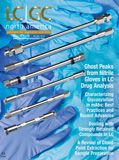What Quadrupole GC–MS Operators Need to Know
LCGC North America
These GC–MS instrument setup requirements are critical to success.
Anyone operating a gas chromatography–mass spectrometry (GC–MS) instrument needs to pay attention to the special requirements that will allow you to get the most from this type of instrumentation. Here, we present a brief summary of a CHROMacademy webcast that deals with key variables and instrument setup requirements.
The ion sources of GC–MS instruments are susceptible to contamination by column bleed products, and the mass spectral background should be kept as low as possible to ensure good sensitivity and reduce spectral interferences. Furthermore, oxygen should be excluded from the carrier gas to prevent gas-phase oxidation of the analytes. For these reasons, it is important to install and regularly check the viability of high-capacity oxygen traps on the GC–MS carrier-gas lines.
Most manufacturers will produce GC column phases that are designated as “MS compatible,” and these will either be the lowest bleed columns identified in quality control (QC) testing, or they may have modified phase chemistry to lower the amount of the bleed. Remember that more-polar, thicker-film columns will inherently bleed more.
Vespel–graphite ferrules are recommended for GC–MS work because they are less permeable to oxygen than the 100% graphite type, although they do suffer more from ferrule “creep” and it may be necessary to tighten the column inlet and detector connections from time to time to avoid leaks.
Take care with column flow rates, because the pumping capacity of most high-quality turbomolecular pumps will limit the column outlet flow to 2–4 mL/min. Also, don’t forget to tell your data system that the pressure at the column outlet is “vacuum” rather than “atmosphere” otherwise the flow and linear velocity will be incorrectly set.
The tuning and calibration intervals for GC–MS are often sources of disagreement. Tuning sets the voltages applied to the various electrostatic elements and lenses within the source and mass analyzer to optimize the instrument response toward the tune compound, which more often than not is perfluorotributylamine (PFTBA), a perfluorinated branched alkylamine. This tuning will give good sensitivity and ensure the correct spectral intensity ratios between fragment masses and their respective 13C isotopes, which helps to improve the accuracy of library search results. The calibration routine will ensure that the mass-to-charge ratio (m/z) x-axis is calibrated across a wide mass range, which is obviously important for library searching, spectral interpretation, and compound identification for quantitative work.
It really is best to run the tuning algorithm before each analytical campaign because settings drift and the ion source and electrostatic elements become coated with less-volatile matrix materials and the required voltages will change, sometimes over surprisingly short periods of time. The repeller or pusher voltage is usually a good measure of source cleanliness, because it is this voltage that accelerates the ions from the ion volume through the lens stacks and into the mass analyzer. The dirtier this element becomes, the higher the voltage required to reach the ion abundance targets of the auto-tune routine. Many folks use electron multiplier (dynode) or channel plate amplification voltages as a measure of source cleanliness; however, this approach is unreliable because the detector active surfaces deplete over time and an increase in the required voltages here does not necessarily indicate a source clean is required.
It is highly recommended that users familiarize themselves with the manufacturers tune “target” values or specification ranges and ensure that these are manually checked after each tune and calibration. Of particular importance are the spectral peak widths, mass assignments, and fragment and isotopic ion abundance ratios as well the electron multiplier (detector) voltage and the repeller voltage. For more-advanced users, you may well wish to tune the quadrupole mass analyzer by optimizing the gain and offset values of the detector rods to optimize sensitivity and resolution. If the manufacturer offers several tune algorithms, be sure to select the most appropriate one for your analysis (high sensitivity and high quality spectra, or general).
Any leaks can also be detected from the PFTBA spectrum produced via the tune report by monitoring 18 (water) and 28 (air, nitrogen) ion abundance. Leaks can be detected by dynamically monitoring mass to charge 28 while spraying the susceptible instrument joints (column inlet, outlet, and the mass analyzer housing seals) with compressed air from a can.
It’s important to ensure that the filaments within the ion source are switched off during the time that the solvent vapor passes through. This time is sometimes known as a solvent delay time, and switching off the filaments avoids burning them out by exposing them to the pressure increase when the relatively large solvent vapor volume passes through the ion source.
When setting up quantitative experiments, remember that the most unique ions for monitoring in selected ion mode (SIM) are higher mass or represent fragments resulting from larger mass losses from the parent ion (but above 50 m/z). Dwell times for ions should be equal unless there is strong justification, and remember to include qualifier ions when performing target analysis so that ion ratios can be checked to confirm identity and lack of interference.
Finally, remember that most quadrupole systems, while being nominally unit mass resolving, can be accurate to 0.1 m/z and there may be sensitivity gains to be had by specifying the ions for SIM mode to 0.1 m/z. That is, monitoring 273.3 m/z may give a significant improvement in sensitivity over monitoring the nominal unit mass of 273.0 m/z.
Get the full tutorial at www.CHROMacademy.com/Essentials (free until February 20).

Understanding FDA Recommendations for N-Nitrosamine Impurity Levels
April 17th 2025We spoke with Josh Hoerner, general manager of Purisys, which specializes in a small volume custom synthesis and specialized controlled substance manufacturing, to gain his perspective on FDA’s recommendations for acceptable intake limits for N-nitrosamine impurities.











